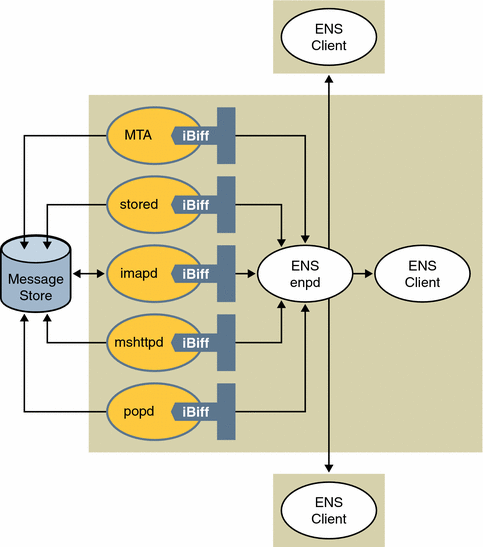How Messaging Server Interacts with ENS
Figure 1–3 shows how ENS interacts with Messaging Server. In this figure, each oval represents a process, and each rectangle represents a host computer running the enclosed processes.
The ENS server delivers notifications from the Messaging Server notification plug-in to ENS clients (that is, iBiff subscribers). There is no guarantee of the order of notification prior to the ENS server because the events are coming from different processes (MTA, stored, and imapd).
Notifications flow from the iBiff plug-in in the MTA, stored, and imap processes to ENS enpd. The ENS client subscribes to the ENS, and receives notifications. When iBiff is enabled, Messaging Server publishes the notifications with the iBiff plug-in, but no Messaging Server services subscribe to these notifications. A customer-provided ENS subscriber or client should be written to consume the notifications and do whatever is necessary. That is, Messaging Server itself does not depend on or use the notifications for its functions, and this is why ENS and iBiff are not enabled by default when you install Messaging Server.
The Messaging Server architecture enforces that a given set of mailboxes is served by a given host computer. A given mailbox is not served by multiple host computers. There are several processes manipulating a given mailbox but only one computer host serving a given mailbox. Thus, to receive notifications, end-users only need to subscribe to the ENS daemon that serves the mailbox they are interested in.
Messaging Server enables you to have either one ENS server for all mailboxes—that is, one ENS server for all the computer hosts servicing the message store—or multiple ENS servers, perhaps one ENS server per computer host. The second scenario is more scalable. Also, in this scenario, end users must subscribe to multiple ENS servers to get the events for mailboxes they are interested in.
Thus, the architecture requires an ENS server per computer host. The ENS servers and the client processes do not have to be co-located with each other or with messaging servers.
Figure 1–3 ENS in Messaging Server Overview

- © 2010, Oracle Corporation and/or its affiliates
